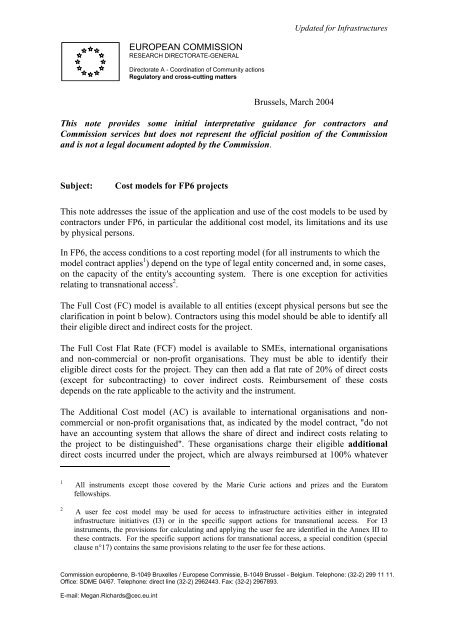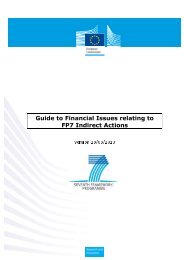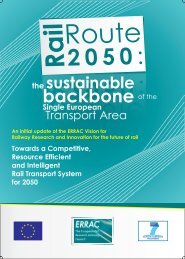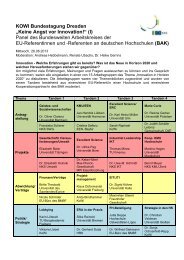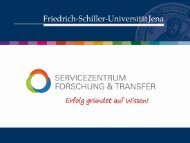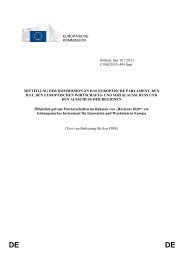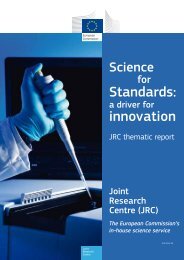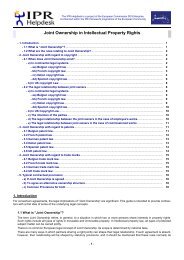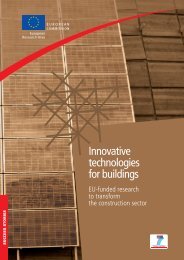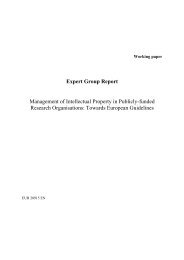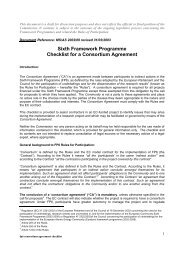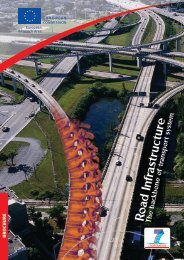Cost models for FP6 projects - European Commission - Europa
Cost models for FP6 projects - European Commission - Europa
Cost models for FP6 projects - European Commission - Europa
You also want an ePaper? Increase the reach of your titles
YUMPU automatically turns print PDFs into web optimized ePapers that Google loves.
Updated <strong>for</strong> Infrastructures<br />
EUROPEAN COMMISSION<br />
RESEARCH DIRECTORATE-GENERAL<br />
Directorate A - Coordination of Community actions<br />
Regulatory and cross-cutting matters<br />
Brussels, March 2004<br />
This note provides some initial interpretative guidance <strong>for</strong> contractors and<br />
<strong>Commission</strong> services but does not represent the official position of the <strong>Commission</strong><br />
and is not a legal document adopted by the <strong>Commission</strong>.<br />
Subject:<br />
<strong>Cost</strong> <strong>models</strong> <strong>for</strong> <strong>FP6</strong> <strong>projects</strong><br />
This note addresses the issue of the application and use of the cost <strong>models</strong> to be used by<br />
contractors under <strong>FP6</strong>, in particular the additional cost model, its limitations and its use<br />
by physical persons.<br />
In <strong>FP6</strong>, the access conditions to a cost reporting model (<strong>for</strong> all instruments to which the<br />
model contract applies 1 ) depend on the type of legal entity concerned and, in some cases,<br />
on the capacity of the entity's accounting system. There is one exception <strong>for</strong> activities<br />
relating to transnational access 2 .<br />
The Full <strong>Cost</strong> (FC) model is available to all entities (except physical persons but see the<br />
clarification in point b below). Contractors using this model should be able to identify all<br />
their eligible direct and indirect costs <strong>for</strong> the project.<br />
The Full <strong>Cost</strong> Flat Rate (FCF) model is available to SMEs, international organisations<br />
and non-commercial or non-profit organisations. They must be able to identify their<br />
eligible direct costs <strong>for</strong> the project. They can then add a flat rate of 20% of direct costs<br />
(except <strong>for</strong> subcontracting) to cover indirect costs. Reimbursement of these costs<br />
depends on the rate applicable to the activity and the instrument.<br />
The Additional <strong>Cost</strong> model (AC) is available to international organisations and noncommercial<br />
or non-profit organisations that, as indicated by the model contract, "do not<br />
have an accounting system that allows the share of direct and indirect costs relating to<br />
the project to be distinguished". These organisations charge their eligible additional<br />
direct costs incurred under the project, which are always reimbursed at 100% whatever<br />
1<br />
2<br />
All instruments except those covered by the Marie Curie actions and prizes and the Euratom<br />
fellowships.<br />
A user fee cost model may be used <strong>for</strong> access to infrastructure activities either in integrated<br />
infrastructure initiatives (I3) or in the specific support actions <strong>for</strong> transnational access. For I3<br />
instruments, the provisions <strong>for</strong> calculating and applying the user fee are identified in the Annex III to<br />
these contracts. For the specific support actions <strong>for</strong> transnational access, a special condition (special<br />
clause n°17) contains the same provisions relating to the user fee <strong>for</strong> these actions.<br />
<strong>Commission</strong> européenne, B-1049 Bruxelles / Europese Commissie, B-1049 Brussel - Belgium. Telephone: (32-2) 299 11 11.<br />
Office: SDME 04/67. Telephone: direct line (32-2) 2962443. Fax: (32-2) 2967893.<br />
E-mail: Megan.Richards@cec.eu.int
Annex I to note Ad/I-5231<br />
the activity 3 and whatever the instrument 4 . This means that such entities are eligible to<br />
use the additional cost model if they cannot distinguish the share of direct and indirect<br />
costs which will be involved in the project (i.e. they are not able to calculate the share of<br />
the direct and indirect costs to the project). They may be able to indicate overall, as an<br />
institution, the share of their direct and indirect costs but not at project level and/or not<br />
be able to distinguish the share between direct and indirect costs in a particular case.<br />
If a non-commercial or non-profit organisation or international organisation is able to<br />
identify its resources involved in the project and to determine the share of direct and<br />
indirect costs <strong>for</strong> the project (i.e. able to quantify both), it has the choice between the<br />
FCF model and the FC model. If such an organisation is able to calculate all its direct<br />
costs in a project, but cannot calculate its indirect costs <strong>for</strong> the project, it has the choice<br />
between the FCF model and the AC model.<br />
A non-commercial or non-profit organisation or international organisation that worked<br />
on AC in shared-cost <strong>projects</strong> under FP5, whose accounting system has not changed<br />
since then, should be able to use the AC model under <strong>FP6</strong>. However, such an<br />
organisation that used FC (not FF) under FP5 would need to provide a substantial<br />
argument to show that it no longer has the capacity to identify its indirect costs even<br />
though it could do so in the past.<br />
Although the basic principles of FP5 have been retained in <strong>FP6</strong> there are a number of<br />
factors that have changed and mean that the cost <strong>models</strong> and their application are not a<br />
mirror image of what was applied under FP5. These include:<br />
- a change in the legal framework (new Financial Regulation of the Communities;<br />
new Framework Programme and new instruments; new definition of eligible costs)<br />
- unlike FP5, all the cost reporting <strong>models</strong> are applied in all instruments (except<br />
<strong>for</strong> Marie Curie Actions and the user fee <strong>for</strong> access to infrastructures); whereas in FP5<br />
there are two different definitions of additional cost depending of the type of action<br />
(shared costs actions = additional costs; thematic network = additional work)<br />
- in most instruments even contractors working on FC or FCF can receive 100%<br />
funding <strong>for</strong> costs in certain activities, such as management activities and training, and in<br />
some instruments all activities are reimbursed at up to 100% whatever the cost model<br />
used.<br />
The executive summary to the Guide to Financial issues relating to indirect actions in<br />
<strong>FP6</strong> also provides a short review of the terms and conditions <strong>for</strong> access to the cost<br />
<strong>models</strong>. It can be found on the model contract web site at:<br />
http://europa.eu.int/comm/research/fp6/workinggroups/model-contract.<br />
Some further clarifications:<br />
3<br />
4<br />
There is a special exception <strong>for</strong> management activities. For these activities the costs of permanent<br />
personnel may be charged if the direct costs can be identified.<br />
For infrastructure instruments there is a cap on the EC funding of 50% <strong>for</strong> Integrated Infrastructure<br />
Initiatives concerning connectivity services and 10% <strong>for</strong> infrastructure construction actions, which<br />
applies also to contractors working on AC basis.<br />
2
Annex I to note Ad/I-5231<br />
a) non-commercial or non-profit organisations established under public law or<br />
private law are not companies that have not made a profit or have not been<br />
successful in the market place. The Framework Programme decision clearly<br />
indicates in footnote 4 in Annex III that additional cost is a possibility and can be<br />
offered “subject to specific conditions [to] specific legal entities, particularly public<br />
bodies, [who] will receive funding of up to 100% of their marginal/additional<br />
costs”<br />
b) physical persons – these are individuals participating as contractors in RTD<br />
<strong>projects</strong>. In such cases, they use the AC model and as such may not charge any<br />
labour costs <strong>for</strong> their personal contribution to the project. However, in some cases<br />
although the legal <strong>for</strong>m of the contractor may be that of a physical person, such as<br />
an unincorporated company owned by one person, the nature of the contractor is<br />
not that of an individual participating as such. Where such a person is engaged in<br />
commercial activities, with an accounting system and capable of identifying its<br />
direct and or indirect costs (as is the case <strong>for</strong> certain professions or <strong>for</strong> SMEs) and<br />
is considered to be an SME then it is more appropriate to use either the FCF or FC<br />
model. The AC model is designed <strong>for</strong> certain kinds of entities, usually public<br />
bodies, which cannot identify their full costs incurred in a project, and <strong>for</strong> physical<br />
persons participating as individuals in the project.<br />
c) different cost <strong>models</strong> within the same legal entity – it is possible that a legal<br />
entity that normally uses the AC model has departments or institutes that are part of<br />
the same legal entity but have a completely separate financial administration and<br />
are capable of using the FC cost model. In these cases, a special condition has<br />
been adopted (special clause n° 22), that allows the legal entity to diverge from the<br />
basic principle that it must use the same cost model in all contracts and allows its<br />
particular department or institute to use the FC model.<br />
3


